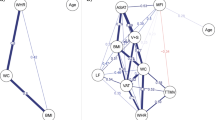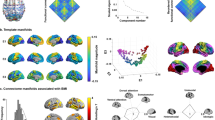Abstract
In this analysis, we bring together two research fields that have never been associated before: the clinical issue ‘Quételet's body-mass index and longevity’ and the comparative biological issue ‘body–brain allometry’. Comparison of medical and biological data supports the view that body mass index is just a one-to-one mapping of the body–brain–energy balance—a biological variable indicating that an individual maintains its systemic energy homeostasis and therefore is likely to perform well in the coming years.
This is a preview of subscription content, access via your institution
Access options
Subscribe to this journal
Receive 12 print issues and online access
$259.00 per year
only $21.58 per issue
Buy this article
- Purchase on Springer Link
- Instant access to full article PDF
Prices may be subject to local taxes which are calculated during checkout

Similar content being viewed by others
References
Whitlock G, Lewington S, Sherliker P, Clarke R, Emberson J, Halsey J et al. Body-mass index and cause-specific mortality in 900 000 adults: collaborative analyses of 57 prospective studies. Lancet 2009; 373: 1083–1096.
Pischon T, Boeing H, Hoffmann K, Bergmann M, Schulze MB, Overvad K et al. General and abdominal adiposity and risk of death in Europe. N Engl J Med 2008; 359: 2105–2120.
Bales CW, Buhr GT . Body mass trajectory, energy balance, and weight loss as determinants of health and mortality in older adults. Obes Facts 2009; 2: 171–178.
Quételet MA . A Treatise on Man and the Development of His Faculties. William and Robert Chambers: Edinburgh, 1842.
Holzenberger M, Dupont J, Ducos B, Leneuve P, Geloen A, Even PC et al. IGF-1 receptor regulates lifespan and resistance to oxidative stress in mice. Nature 2003; 421: 182–187.
Taguchi A, Wartschow LM, White MF . Brain IRS2 signaling coordinates life span and nutrient homeostasis. Science 2007; 317: 369–372.
Armstrong E . Relative brain size and metabolism in mammals. Science 1983; 220: 1302–1304.
Mink JW, Blumenschine RJ, Adams DB . Ratio of central nervous system to body metabolism in vertebrates: its constancy and functional basis. Am J Physiol 1981; 241: R203–R212.
Martin RD . Relative brain size and basal metabolic rate in terrestrial vertebrates. Nature 1981; 293: 57–60.
Glazier DS . Beyond the ‘3/4-power law’: variation in the intra- and interspecific scaling of metabolic rate in animals. Biol Rev Camb Philos Soc 2005; 80: 611–662.
Hofman MA . Energy metabolism, brain size and longevity in mammals. Q Rev Biol 1983; 58: 495–512.
Hofman MA . Encephalization and the evolution of longevity in mammals. J Evol Biol 1993; 6: 209–227.
Peters A, Schweiger U, Pellerin L, Hubold C, Oltmanns KM, Conrad M et al. The selfish brain: competition for energy resources. Neurosci Biobehav Rev 2004; 28: 143–180.
Aiello LC, Wheeler P . The expensive-tissue hypothesis: the brain and the digestive system in human and primate evolution. Curr Anthropol 1995; 36: 199–221.
Krieger M . On the atrophy of human organs in inanition. Z Angew Anat Konstitutionsl 1921; 7: 87–134.
Oltmanns KM, Melchert UH, Scholand-Engler HG, Howitz MC, Schultes B, Schweiger U et al. Differential energetic response of brain vs. skeletal muscle upon glycemic variations in healthy humans. Am J Physiol Regul Integr Comp Physiol 2008; 294: R12–R16.
Later W, Bosy-Westphal A, Hitze B, Kossel E, Glüer C-C, Heller M et al. No evidence of mass dependency of specific organ metabolic rate in healthy humans. Am J Clin Nutr 2008; 88: 1004–1009.
Sokoloff L . Circulation & energy metabolism of the brain. In: Siegel G, Agranoff B, Albers RW, Molinoff P (eds). Basic Neurochemistry. Raven Press: New York, 1989, pp 565–590.
Peters A, Langemann D . Build-ups in the supply chain of the brain: on the neuroenergetic cause of obesity and type 2 diabetes mellitus. Front Neuroenergetics 2009; 1: 2.
Acknowledgements
This work was supported by grants from the German Research Foundation (DFG Mü 714/8-3 and Clinical Research Group KFO-126).
Author information
Authors and Affiliations
Corresponding author
Ethics declarations
Competing interests
The authors declare no conflict of interest.
Rights and permissions
About this article
Cite this article
Peters, A., Hitze, B., Langemann, D. et al. Brain size, body size and longevity. Int J Obes 34, 1349–1352 (2010). https://doi.org/10.1038/ijo.2010.65
Received:
Revised:
Accepted:
Published:
Issue Date:
DOI: https://doi.org/10.1038/ijo.2010.65
Keywords
This article is cited by
-
Body composition-related functions: a problem-oriented approach to phenotyping
European Journal of Clinical Nutrition (2019)
-
From the past to future: from energy expenditure to energy intake to energy expenditure
European Journal of Clinical Nutrition (2017)
-
BMI and the metabolic rates of brain and body
International Journal of Obesity (2011)



